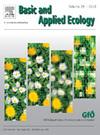Moving north under the eye of the public: The dispersal ecology of the Nosferatu spider, documented by citizen scientists
IF 3.5
2区 环境科学与生态学
Q2 ECOLOGY
引用次数: 0
Abstract
Citizen participation in tracking the spread of newly introduced or invasive species is an effective tool in nature conservation. Recently arrived species that pose threats to humans, animals, or plants—especially those widely covered in the media—are particularly suitable for citizen-led monitoring.
In this study, we selected the Nosferatu spider (Zoropsis spinimana), a species spreading from the Mediterranean to northern Europe, to investigate whether its media coverage motivates citizens to report observations. Additionally, we aimed to gather insights into the spider's dispersal ecology through citizen science data. We utilized Google News and Google Videos as indicators of media presence, Google Trends as a proxy for public awareness, and citizen science observation data to assess the spider's distribution and ecology. Our analysis of 3,017 citizen science observations from different sources revealed a north-eastern spread of Z. spinimana. We found a temporal correlation between media presence, Google search activity, and the number of citizen-reported observations. Additionally, there was a strong spatial correlation between federal states with the highest media presence and the highest number of citizen reports. Most observations were recorded between August and October, with the majority occurring inside human dwellings. Hence, the current dispersion dynamics and extensive media coverage of Z. spinimana appear to be significant factors driving increased public awareness, as evidenced by higher search interest and a greater number of citizen observations.
在公众的注视下向北移动:由公民科学家记录的Nosferatu蜘蛛的扩散生态
公民参与追踪新引进或入侵物种的传播是自然保护的有效工具。对人类、动物或植物构成威胁的新物种——尤其是那些被媒体广泛报道的物种——特别适合由公民主导的监测。在这项研究中,我们选择了Nosferatu蜘蛛(Zoropsis spinimana),一种从地中海传播到北欧的物种,来调查它的媒体报道是否会激励公民报告观察结果。此外,我们的目标是通过公民科学数据收集蜘蛛传播生态的见解。我们利用谷歌新闻和谷歌视频作为媒体存在的指标,谷歌趋势作为公众意识的代理,以及公民科学观察数据来评估蜘蛛的分布和生态。我们分析了来自不同来源的3017个公民科学观察结果,揭示了Z. spinimana的东北传播。我们发现媒体存在、谷歌搜索活动和公民报告的观察数量之间存在时间相关性。此外,媒体曝光率最高的联邦州与公民报告数量最高的联邦州之间存在很强的空间相关性。大多数观测是在8月至10月期间记录的,大多数发生在人类住宅内。因此,目前Z. spinimana的传播动态和广泛的媒体报道似乎是推动公众意识提高的重要因素,正如更高的搜索兴趣和更多的公民观察所证明的那样。
本文章由计算机程序翻译,如有差异,请以英文原文为准。
求助全文
约1分钟内获得全文
求助全文
来源期刊

Basic and Applied Ecology
环境科学-生态学
CiteScore
6.90
自引率
5.30%
发文量
103
审稿时长
10.6 weeks
期刊介绍:
Basic and Applied Ecology provides a forum in which significant advances and ideas can be rapidly communicated to a wide audience. Basic and Applied Ecology publishes original contributions, perspectives and reviews from all areas of basic and applied ecology. Ecologists from all countries are invited to publish ecological research of international interest in its pages. There is no bias with regard to taxon or geographical area.
 求助内容:
求助内容: 应助结果提醒方式:
应助结果提醒方式:


